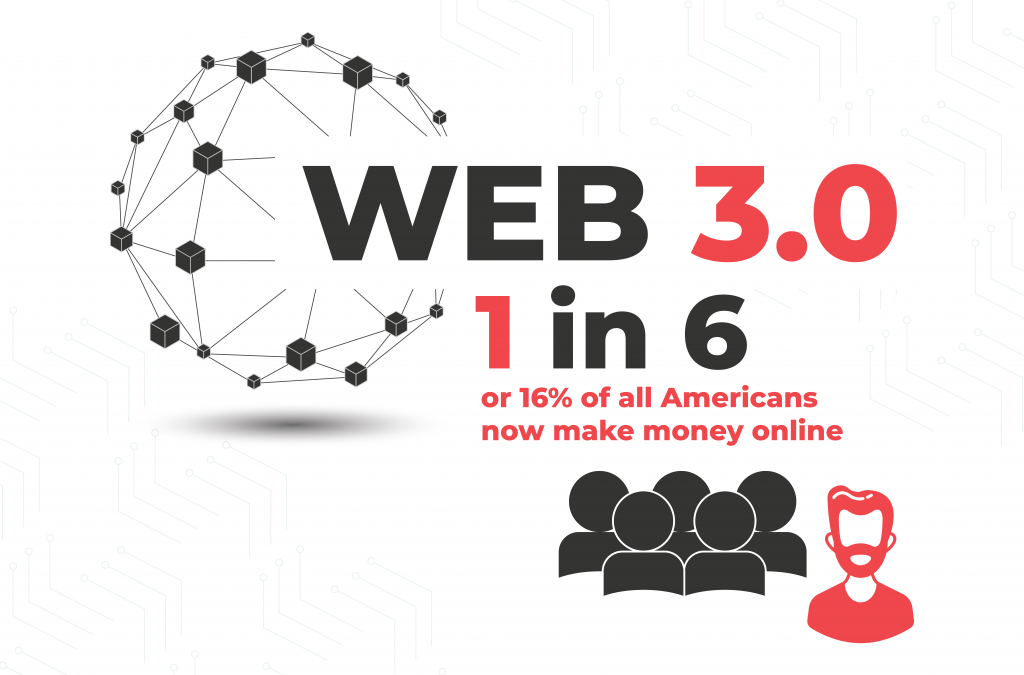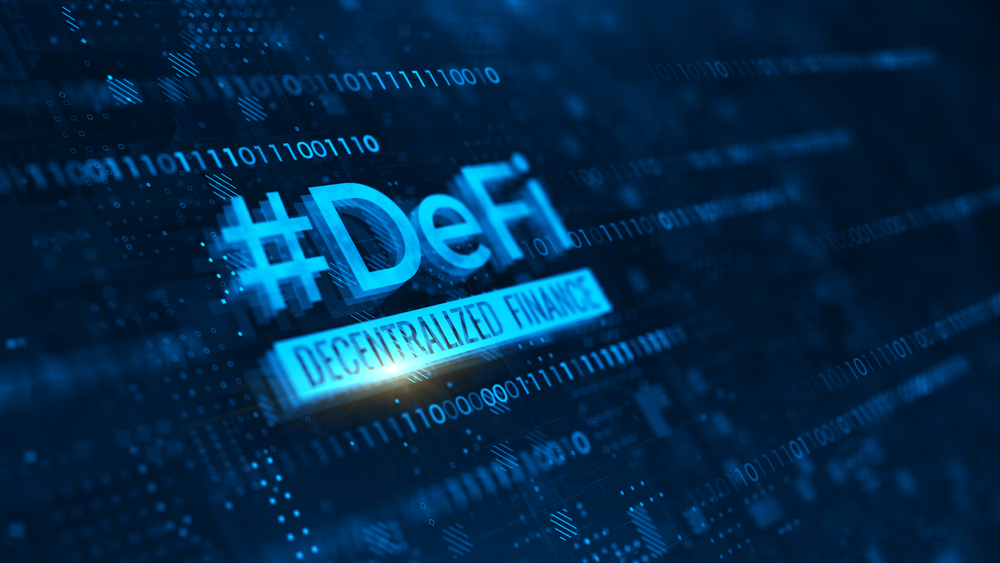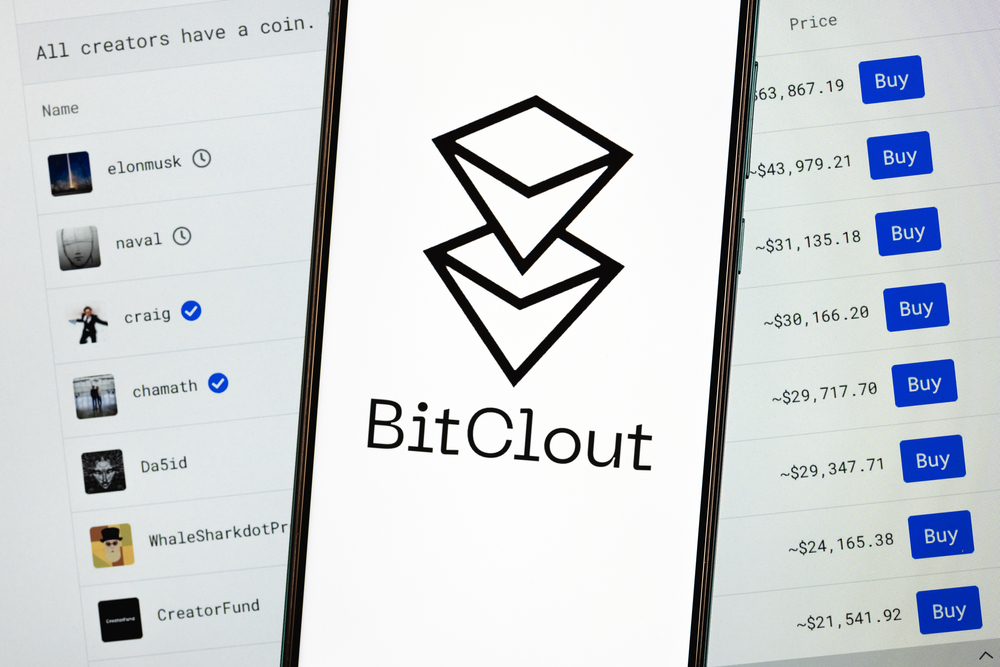
These days, you’re likely well aware how the major players like Facebook and Google — among very few others — make tremendous amounts of money on the world wide web. The services of these web giants are free. By using these web giants, average people like you and me in the real world offer up an enormous amount of data unwittingly.
These companies then repackage and sell this information for a variety of purposes. This business model is called web 2.0. It is the second iteration of how the internet works following the good old days of AOL. The early stages were called web 1.0. But things are changing in the online world, and changing fast.
Challenging the primacy of web 2.0 is an underlying financial model for how the internet operates called web 3.0 There are ways to make money with Web 3.0. Here’s what you need to know about the monetization of the Metaverse.
What is Web 3.0?

This economic engine for the decentralized internet is moving away from the absolute control of Silicon Valley tech monoliths to peer-to-peer networks operating with no third parties at all. What is Web 3.0 examples:
- Apple’s Siri
- Wolfram|Alpha
- NFTs
- any number of cryptocurrency platforms supported by blockchain protocols like Privi
This system helps preserve data privacy. This creates opportunities for average users to find value, interact with data, and most importantly, make more money with the internet. This redistributes many of the online wealth-generating opportunities which had consolidated in the hands of the very few.
And partially because of this, one in six or 16% of all Americans now make money online. That number is only expected to increase in the coming years as web3 takes hold.
Machine learning is a powerful tool that can be utilized in Web3 to:
- analyze data and patterns, enabling individuals to make informed investment decisions
- generate income in decentralized finance (DeFi) or non-fungible token (NFT) markets
In this article, we’ll provide an introduction to these opportunities for how to make money with Web 3.0.
How to Make Money with Web 3.0

Just a few of the profit models created by this new internet system include the following:
Earn money off your own data
By now it’s widely known that the web 2.0 model, as it stands, means tech giants Facebook and Google make a lot of money gathering and selling our data which we have offered up, free of charge, every time we interact with their platforms. What do we get in the deal? Absolutely nothing, save a quick and convenient way to look up a chicken soup recipe, as is the case with Google.
As it stands now, given the power of web 2.0, it’s unlikely this system will change anytime soon. What web 3.0 promises, however, is an opportunity for average people like you and me to see a little return on all that data we create every time we go online. It’s all because of blockchain technology.
How to sell data and earn money? Blockchain is owned by the people who own the platforms on which the blockchain operates — average folks, rather than Silicon Valley tech gurus. This way, the data generated on blockchain stays with the people who are generating it. Thanks to web 3.0 protocols, the day when we can collect, privatize, and therefore monetize our own data is closer than ever.
Mint your own currency
That’s right, minting currency is no longer the sole domain of the Federal Reserve. It’s all made possible through web 3.0 technology, and creating your own personal tokens or cryptocurrency through platforms like Privi. By assigning a dollar amount to these tokens, they can be distributed to your social media following, or via some other networking system. Those produced can then be used to pay the content creator for their product or service.
Based on the quality of the content, the bigger the following, the more personal tokens in circulation, and the more transactions occur. With more transactions, the value of the personal token increases, as does demand. Best of all, the creator remains in control of the overall supply of these tokens, something like company currency or scrip. Those who have tokens of their own are incentivized to share the content they purchased with the tokens. This increases demand and therefore the value of the tokens they own.
In other words, you may one day be able to buy digital music from Radiohead, using Radiohead Bucks, minted and controlled by Radiohead themselves. But this system won’t just benefit major rock stars. It could also benefit smaller artists and content creators writing code, building their own apps, or making any kind of digital content to buy and sell on the crypto marketplace. These systems are still in their infancy, but they’re here to stay, and growing fast.
Democratize ownership of physical properties
No matter what iteration of the internet is most current — from web 3.0 to web 304 — most value will remain locked up in physical assets like real estate, apartments, and condos in the major cities of the world, or even vacation properties in some of the world’s most far flung and desirable destinations.
Thanks to web 3.0, instead of listing a property for sale on the local real estate market, property owners could essentially make their property a digital asset backed by an NFT. These properties are able to be purchased in incredibly small increments, sometimes as small as 1% of the value, and with nothing more than some crypto. The property would then be managed by a decentralized insurance pool.
This presents two money making opportunities: for the real estate owner, seeking to broaden and diversify the market for their properties outside the traditional real estate industry, and for average people — just like you and me — to finally get a piece of the booming real estate markets in prosperous areas.
Revolutionize the credit industry
Most anyone with a basic knowledge of economics understands one important principle: monopolies are bad, competition is good. Because big banks almost exclusively control the credit industry, they set the rules for who does or doesn’t receive credit, shutting many average everyday people out of investment and money making opportunities, and often, for very arbitrary reasons.
With web 3.0 the stranglehold big banks have had on credit could be disrupted through decentralized credit pools. Rather than borrowing from a big bank, what this would mean is groups of crypto lenders who agree how much they’re willing to lend, and how much interest they’d like to make in return. Those returns are unlikely to be as astronomical as those enjoyed by JP Morgan, for example.
A decentralized credit industry could generate revenue for the lender, while also increasing access to all-important credit for people who might otherwise be shut out. This could help them start businesses to make money on their goods and services, or even just accumulate wealth, all on their own.
Start or Work for Working a Decentralized Autonomous Organization (DAO)
Thanks to web3, a DAO or decentralized autonomous organization, sometimes called a decentralized autonomous corporation, may just be the employer of the future, or instead, the solution for contributing money (in this case crypto) to causes and charity work.
Bitcoin already operates this way. But what is a DAO, you ask? Decentralized autonomous organizations are collectively owned entities that operate with no central leadership, but instead, sets of rules, operating standards, and company policies and protocols, existing on the blockchain, and that are able to be changed, updated, and revised at any point through membership consensus.
A DAO could make money through financial transactions, backed with a smart contract. Most entities of this type are funded by issuing tokens (essentially it’s own cryptocurrency) that are then distributed to the membership. Any transaction conducted with a DAO, or between the collective and another entity are recorded, visible, and completely verifying on the blockchain.
DAO’s are highly democratic, and they can do business or champion specific causes with like-minded folks anywhere in the world, with little bureaucracy, no bosses, and few third-parties. Everything is kept open, honest, and verifiable with the power of the blockchain and web3.
How To Make Money Online: Digital Art and Video Games
There is a lot of hype around Web 3.0 and video games in virtual worlds and online platforms. The intersection of these two fields presents an opportunity for making money in the Web 3.0 ecosystem. Here are some ways you can make a passive income with Web 3.0 and video games:
- Play-to-earn games – These games are built on blockchain technology. Games such as Axie Infinity have gained popularity in recent years. Players can earn cryptocurrency by breeding, battling, and trading their Axies. The games run on Ethereum blockchain (Eth).
- Streaming and Content Creation – Platforms such as Twitch and YouTube allow gamers to stream their gameplay and earn money through subscriptions, donations, and sponsorships. Gamers can also create content such as guides, tutorials, and reviews, which can generate revenue through ad revenue and affiliate marketing.
- Virtual Reality– VR gaming is a quickly growing industry. Decentralized gaming platforms such as Enjin allow gamers to earn cryptocurrency by completing in-game quests and challenges.
Digital art in Web 3.0 refers to the intersection of digital artwork and the decentralized, user-centric nature of the web. It involves using emerging technologies like:
- blockchain
- NFTs
- smart contracts
These technologies create, distribute, and monetize digital art in a transparent and secure manner.
With web 3.0, artists:
- have greater control over their work
- establish provenance
To make money with digital art and video games, you can sell your artwork online through platforms like NFT marketplaces or art marketplaces. You can make money from your video game skills (through ads, sponsorships, donations) by:
- participating in esports tournaments
- streaming gameplay (Twitch, YouTube)
- providing services as a game developer
Web 3.0 Business Opportunities

Broadly speaking, we’ve covered the most common ways that web3 will revolutionize the internet, creating new and innovative revenue streams and digital assets. In our next section, we’ll cover a few pre-existing business models that could particularly benefit or be completely remade in the world of web 3.0.
SaaS (Software as a Service)
First up in how to make money from web 3.0 is SaaS. This business model based on revenue created through software subscription, is nothing new. Many traditional businesses already make money on the internet in this fashion. They charge a subscription fee to another business, organization, or entity for the benefit of using a particular piece of software central to their operation.
An opportunity created by web3 however is that blockchain, or in other words, hosting a crypto wallet for another business, can become a service for which a business can charge a fee.
Is there an old-school dry cleaner in your area interested in the ability to accept crypto from their customers? Thanks to the EIP1337 upgrade on Ethereum, eliminating private key authorization for blockchain transactions, it’s easier than ever for your web 3.0 business to host that company’s crypto wallet for a monthly fee, payable in — you guess it — crypto.
Web advertising

At this point, we’re well aware that our browsers are watching our every move online. They show us advertising paid for by companies and corporations large and small, and with the browser algorithms deeming what’s interesting to us based on our online behavior. All the revenue generated by this advertising filters up to the company that owns the browser.
What if that money could be shared instead between the advertiser, the browser, and you — the entity creating value by just existing on the internet?
In the world of web 3.0, this will be possible, and one company already taking advantage of this is the Brave web browser. They offer what’s called BAT, or basic attention tokens. Here’s how they work. Just like with any other browser, advertisers pay Brave, and Brave then displays ads to its users, customized to their online behavior on the browser.
What’s different about Brave, though, is the revenue generated by that advertising is shared equally with:
- Brave
- the advertiser
- you
The consumer in a kind of crypto called BAT, issued and controlled by Brave. Finally, the value created by your attention in the attention economy will be partially yours to enjoy.
Revenue Sharing and Decentralized Finance (DeFi)

The whole system of blockchain and tokenomics is also remaking the financial industry from the ground up. This breaks lending away from the shackles of fractional reserve lending, and finally allowing consumer credit to be issued at scale.
What defi does is allow certain web3 startups like Celsius and Compound Finance to encourage savings in stablecoins. They offer incentive interest rates as much as 10% or higher, and annual yields between 5% and 7%, issued in the asset saved.
The reason being is that with fractional reserve banking, financial institutions are allowed to lend more than they have on hand, so long as they maintain a fraction of their ledger in liquidity, gambling that as consumers make their monthly payments, coffers will be adequately refilled, enabling them to lend again.
In the past an interest rate would incentivize a consumer to save with a particular bank. Now, fractional reserve banking keeps those rates quite low — typically around .6%. What defi does is return lending to the days before fractional reserve banking.
As more people save their money in a particular token, the more can be lent, with returns gathered in the interest rate on the loan. Therefore the higher interest rate can be on the asset saved, benefiting everyone.
BaaS (Sometimes called MBaaS or Backend as a Service)

This is another money making area greatly opened up by web 3.0. Traditional baas services might include website hosting or data storage provided to a third party company for a fee. In the new economic model of the internet, backend as a service becomes blockchain as a service. This opens up the power of the blockchain for a whole new range of purposes and money making opportunities.
One example is backing up the authenticity of certain kinds of high-end products like sneakers and watches. With the transparent nature of blockchain, consumers could be confident that what they’re buying is the real thing. Web3 baas manages the blockchain for the manufacturer so they can focus on their products.
Some companies in particular making significant headway in this area include:
- Dragonchain-offering their own token and provides hybrid blockchain platform solutions for small and independent developers
- TrustFi, specializing in defi and crypto asset assurance, liquidity management
- DAO governance-providing the blockchain on which company protocols are maintained
So, what does this all mean to you? You’re an independent entrepreneur, or perhaps an artist or content creator, wondering how to leverage web3 to make some money? We’ll conclude our article on how to make money with web 3.0 offering some real-world examples of how to turn a bunch of techno jargon into reliable revenue.
Market yourself on BitClout

It isn’t just the world of finance that’s been completely changed by the power of blockchain. Social media can also become much more decentralized on web3. Leading the way is BitClout. BitClout:
- gives content creators more control of their own following
- seeks and manages investment opportunities from that crypto
- has the final say on who sees your content, when, where, and how.
There are Bitclout versions of Twitter, YouTube, and even Spotify in the works. The future for content creators to make money could be platforms like these.
Monetize your own blog

Built on Ethereum, Mirror.xyz helps writers maintain a blog, with control of how the content is monetized, how it’s published, and finally, maintaining ultimate ownership of all your content. It works by essentially turning your writing or post into an NFT, putting on the blockchain under your permanent ownership, letting you move it from one platform to another at the discretion of the content creator.
Further revenue models for content creators made possible with web3 include:
- turning your content into an NFT, and charge a subscription for access
- letting your followers invest in your work, and offering a dividend to those investors in return
- approaching brands, businesses, and corporations, allowing them to purchase advertising or promotional opportunities in your content as an NFT
How To Make Money With Web 3.0: The Bottom Line

Major players like Google and Facebook have controlled the internet for far too long. They make incredible amounts of money from our data which we offer up willingly every time we go online. This is an economic model known as web 2.0.
Web 3.0, sometimes called web3 is based on cryptocurrency, NFT, and the transparent nature of the blockchain. It is here to challenge the primacy of the old guard, democratizing the internet, and the attendant money-making opportunities once more.
In this article, we provided an overview of how to make money with web 3.0, as well as some revenue opportunities and business models made possible by this new paradigm.
With web3, it’s possible to:
- Make money off your own data
- Mint your own currency
- Democratize ownership of physical properties
- Revolutionize the credit industry
- Start or work for working a decentralized autonomous organization (dao)
Some revenue opportunities created or facilitated by web 3.0 include:
- SaaS, or software as a service
- Web advertising
- Revenue Sharing and Decentralized Finance (DeFi)
- BaaS, or backend as a service (in this case, blockchain)
- Decentralized applications (dApps)
Web3 also opens up opportunities for independent content creators to market themselves on a truly decentralized social media platform, and new ways to monetize a blog and readership.
Much of web3’s potential is still developing, and all that opportunities it creates remain to be seen. Keeping an eye on areas we’ve outlined in this article will keep you ahead of the competition when the day eventually comes, and web 3.0 reigns supreme over the internet.
Digital marketing is changing with the arrival of Web 3.0. It brings decentralized platforms and blockchain technology. This makes marketing more transparent and secure. Marketers can focus on privacy and personalized experiences to connect with customers in new and exciting ways.
Artificial Intelligence (AI) is playing a critical role in shaping the future of Web 3.0. With AI, websites and apps can learn from user interactions. This provides personalized experiences. AI- powered chatbots are becoming more prevalent. They can offer assistance and enhance customer support. Web 3.0 allows AI algorithms to process vast amount of data securely. This leads to smarter decision-making and improved efficiency. As AI and Web 3.0 continue to advance, there is the potential to transform industries and make our online experiences more intelligent and interactive. Only you can decide how you will reap the benefits of making money online.
